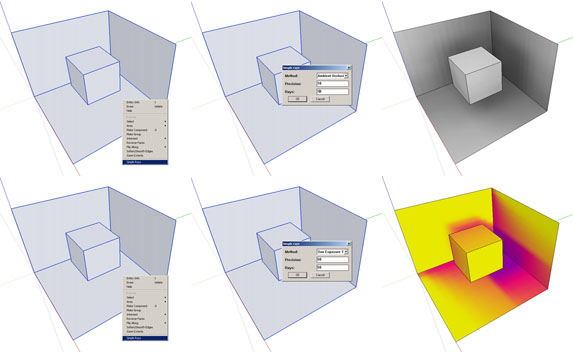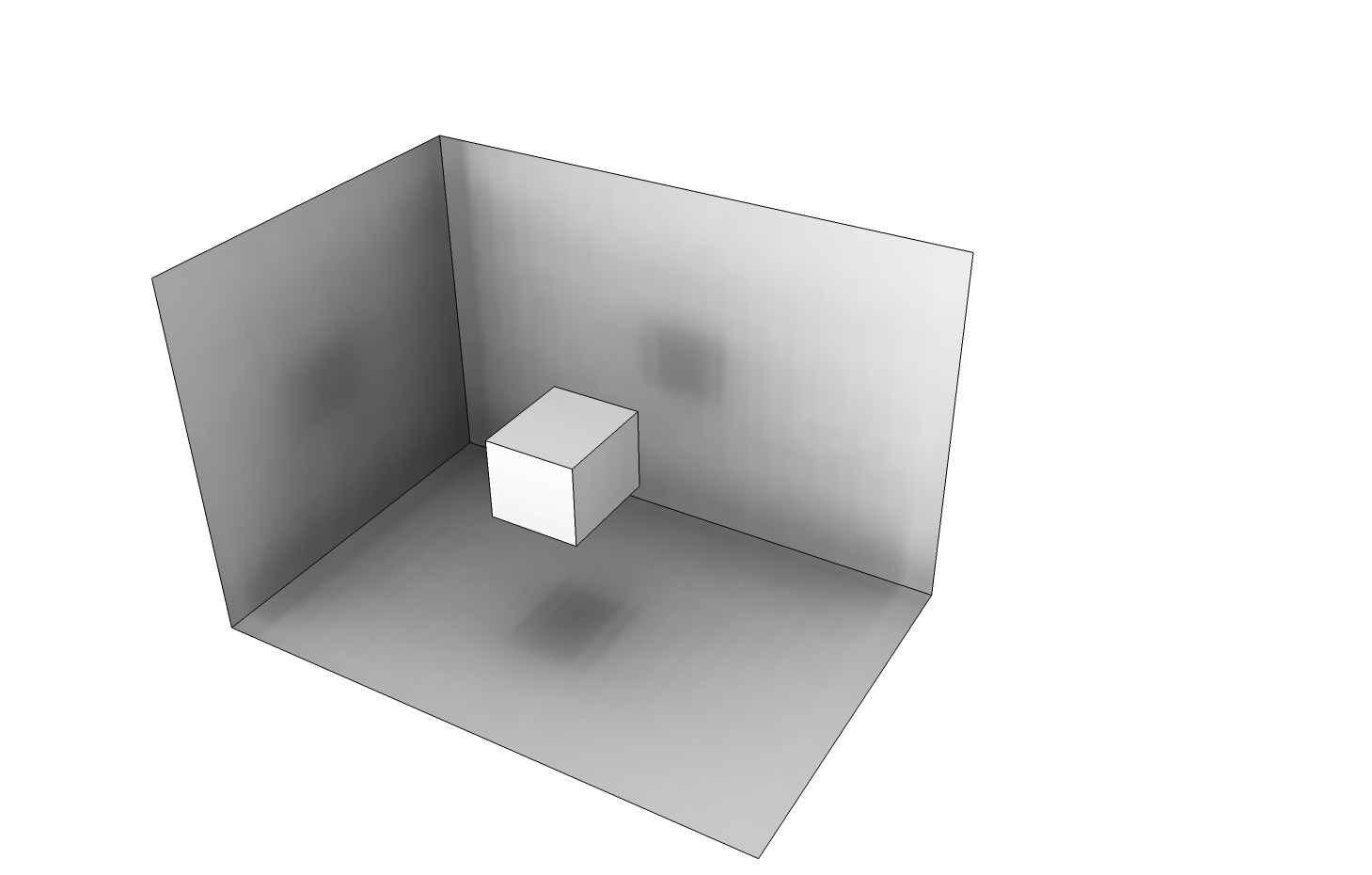[Info] Ambient Occlusion -> Simple Rays
-
This is a crude version of a raycasting plugin that realizes a very straightforward approach to adding soft shadows inside SketchUp. Since I'm no professional coder but an architect at this point it's very slow and is useless for complicated models. It takes two parameters - Precision, which determines probing resolution according to grid = model.bounds.diagonal / precision and Rays which denotes number of rays cast from each point of grid.
[anchor= goto=http://sketchucation.com/forums/viewtopic.php?f=323&t=51950&p=545855#p545855:1hef2rd6]Download it here![/anchor:1hef2rd6]
Here is an explanatory image. Shading took 2-3 seconds.

The plugin works like this:- Extract faces from selection and compute each of them
- Make grid of points and compute each - lightmap method extending Sketchup::Face class
- Cast an array of rays from a point invoking model.raytest method, calculate exposure translate to r, g, b values - exposure method extending Array class
- Write 24-bit BMP texture for each face in a folder "filename_occlusion" along your SketchUp file - Bitmap class
- Position textures on faces
I would appreciate any comments on how I can speed it up and whether this plugin might be of any use.
%(#0000FF)[Version history:
Mon Aug 10, 2009 Modified ray casting algorithm - more even ray casting, resulting also in approx. 2 times more rays cast
Mon Aug 10, 2009 Modified lightmap algorithm - shading time reduced approx. 2 times by reducing number of occlusion calls, added Bitmap.expand method to do the same task, deleted some unused code
Tue Aug 11, 2009 Added Bitmap.blur - texture smoothing
Tue Aug 11, 2009 Added progress info, removed unused parts of code
Wed Aug 12, 2009 Removed Save panel, instead when model is not saved "temp_occlusion" folder is created in the Plugins folder, added Mac compatibility
Wed Nov 25, 2009 Added Sun Exposure Time mode and changed the name of the plugin, rewritten many parts of code, making it a bit faster.]NOTE -
-
Kuba, this is a very interesting plugin from the description. I've tried using it with a model much like the one in your example. I don't get any change, though. Hopefully some of the Ruby gurus will be along to answer your questions.
-
Not working for me too.
This is what the ruby console says:Error: #<NoMethodError: undefined method
+' for nil:NilClass> C:/Archivos de programa/Google/Google SketchUp 7/Plugins/occlusion.rb:403:inambient_occlusion'
C:/Archivos de programa/Google/Google SketchUp 7/Plugins/occlusion.rb:435
C:/Archivos de programa/Google/Google SketchUp 7/Plugins/occlusion.rb:434:in `call'Daniel S
Ps. I don´t know if it´s related... but will be possible to create faces for simulating shadows http://forums.sketchucation.com/viewtopic.php?f=180&t=20396&p=170766 ?
-
Dave R
I don't know what causes the problem. The plugin works only with faces front side only. Did you see any new material appear in Material window after running the plugin?Daniel S
It's a problem with SketchUp file path. Are you using Windows or Mac SketchUp version?
I'm sure that ray casting algorithm can be modified to include sun position.Kuba
-
Kuba, one thing I am very careful about in my SketchUp models is that face orientation is correct. There are only front faces exposed. Here's what I get from the console.
No. there are no new materials generated.
Error: #<NoMethodError: undefined method
+' for nil:NilClass> C:/Program Files/Google/Google SketchUp 7/Plugins/occlusion.rb:403:inambient_occlusion'
C:/Program Files/Google/Google SketchUp 7/Plugins/occlusion.rb:435
C:/Program Files/Google/Google SketchUp 7/Plugins/occlusion.rb:434:in `call'It's the same thing Daniel got.
-
Ok. The problem is obvious.
I worked on an already saved model. I got the same error when working on a new model.
The plugin looked for the path via model.path method and returned nil since it couldn't find it. Maybe better solution would be to create a temporary folder in SketchUp/Plugins and then delete it after all the textures are inside the model.Kuba
-
Saving the file before hand does make it work. The file doesn't need to be saved in the Plugins directory, either. You might want to add a note about that in your first post.
-
Here's an example. This was with the values set at 50 & 50. Maybe about 30 seconds or so. Probably something set too high, though.

Is there any way to control the angle or direction of the shadows?
-
Dave R
Nice image. Thanks for posting
I have to work on blurring and smoothing the shadows as well as on casting rays.I've re-uploaded occlusion.rb. (don't know if this is a good way of posting rewritten code)
Now the plugin will ask you to save the file so you don't have to worry about it.
Kuba
-
Kuba
Saving the model before running the plugin works very well.
I think that will be better to make faces simulating shadows instead of writing textures. The result will not be fantastic, but you can then change the color of shadows or change the opacity, or use a texture...
Anyway I like a lot your plugin
Thank you for sharing it with us!!!.Daniel S
-
Thanks, Kuba.
As to posting updates, yes, you should replace the file in your original post. You should also make a note of the version number and date of update in the title to make it easier for folks to tell there has been an update.
Thanks for making the change.
-
Daniel S
I thought about it first. Before I learned reading/writing BMP files.
But my goal was to render soft shadows.
I can only imagine creating hundreds of tiny faces to simulate smooth color transition.If you have better idea I could implement it.
Kuba
-
For soft shadows your method is better, but with faces and a lot of offsets you can make a good transition.
Here i attach a very quick example (with not very good result, but is to explain the idea).. it will have better results if you make more faces and with not big changes on the value of opacity between each face.
Daniel S
-
Very interesting.

Do you have a "max distance" when calculating occlusion?
That would also help the speed a bit I think since it wouldnt need to continue calculating rays that doesnt hit anything within the given max distance.Also I think it would be great to have an option for it to discard materials or include/blend with the materials/textures in the scene.
Great job so far!
-
its cool thats its actually "baking" the AO onto the faces
 . now if it could overlay the baked AO onto the existing material instead of replacing it
. now if it could overlay the baked AO onto the existing material instead of replacing it 
-
Daniel S
I will think about your idea. I would have to trace lightmap for "isolines" of equal brightness.Pixero
But it would have to check for each ray this max_distance condition, am I right? Rays here don't bounce, they check only if they hit nothing/background.xrok1
I planned this as next stage of developement for it seems quite complicated to me. The simplest way would be to create faces offset by small distance from the original textured face (the same way Daniel S overlays shadow in his model). But then brightness would have to be translated to opacity, which requires PNG format which I'm not familiar with (yet). The other way would be to merge shadow texture with existing one aquired by something similar to 'Make unique texture'.Kuba
-
qpic, this is an excellent plugin. Keep working at it. I am looking forward to the finished version.
I like the idea of merging both the occlusion and the original textures. Maybe it is possible to do that on a pixel-by-pixel basis for each texture. I don't know about standard ruby methods for this, but it may be as trivial as subtracting brightness values.
-
@qpik said:
But it would have to check for each ray this max_distance condition, am I right? Rays here don't bounce, they check only if they hit nothing/background.
If it doesnt hit anything within the given max distance it presumes the surface isnt occluded and moves on. That way you also can control how much spread the occlusion should have. Meaning you could set a low value and just get occlusion in tight corners. Can be nice to have this also.
-
...even that it is still in a beta stage, I would really like to stress that the approach is brilliant!! Great work Qpik!!!
-
Pixero
So you mean to cut down on time by reducing single ray casting procedure, not number of them? That means that instead of using existing model.raytest method I would have to write my own. I'll think about it.
About ambient occlusion method. As i know it from Wikipedia it's based on casting rays from point evenly over a "hemisphere". I plan adding narrowing that angle, but combined with changing it's direction will produce different effect, it will give soft sunlight (fixed direction) or point light (point.vector_to source direction) shadows, where the size of the light source (softness of shadows) will be determined by that angle.Speeding up is crucial for this plugin. I haven't even tried it with complex geometry, because I expect it to run for ages. I don't wan't to add too much functionality before finding out weak points and rewriting it .
I need someone to point out those areas of code which slow it down the most. Maybe Ruby can't do it much faster.Kuba
ps. About values for Resolution and Rays - do you think those default 10,10 are optimal?
Advertisement







